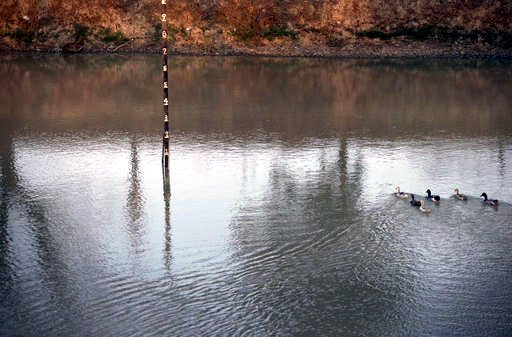
In this May 12, 2016 photo, ducks swim next to a measuring pole in a low water level pond in Dala township, south of Yangon, Myanmar. Droughts, floods, pest infestations and limited agricultural supplies have contributed to most of the Myanmar’s desperate need for food and water. AP
DALA, Myanmar — Every year at this time, the ponds and wells go dry. People walk for hours to fill their plastic buckets at a lotus-filled pond that is the only clean source of drinking water in this community outside Myanmar’s biggest city, Yangon.
The dry season, which typically runs from April through May, has been compounded this year by an El Nino-induced drought that added several months to the water shortage affecting Dala township.
But this year’s dry season has also ushered in a new sense of hope.
The arrival of Aung San Suu Kyi’s government on April 1 opened a new chapter in Myanmar. The Nobel Peace laureate heads the first civilian government after a half-century of military control, meaning the people have great expectations and the democracy crusader has an enormous list of challenges.
“I hope we can get away from this trouble under the new government,” said 35-year old villager Aye Aye Tin, a mother of seven who lined up with dozens of others at the pond, which is fenced off and padlocked. It opens to the public between 5 p.m. and 6 p.m., because there’s only so much water to go around.
Suu Kyi’s government has been digging wells for villagers facing water shortages across the country, as part of the government’s plan for its first 100 days in office. But the needs are still enormous, and many communities, including Dala, have yet to receive much help.
“I am very tired at the end of the day from carrying heavy buckets of water back and forth. I cannot even move at night, but this is how we have to survive,” Aye Aye Tin said.
In this May 12, 2016 photo, children carry drinking water in plastic containers as they balance on a narrow beam of timber across a lotus-filled pond in Dala township, south of Yangon, Myanmar. This year’s dry season, which typically runs from April through May, has been compounded by an El Nino-induced drought that added several months to the water shortage affecting Dala township. AP
Myanmar is one of the poorest nations in the world. Decades of military rule have devastated the country’s infrastructure. Unemployment and economic stagnation have become the norm. Droughts, floods, pest infestations and limited agricultural supplies have contributed to the country’s desperate need for food and water.
A quasi-civilian government in power from 2011-2015 implemented nascent democratic reforms that have resulted in a development boom, with the World Bank and others pouring billions of dollars into the country of 60 million as it starts to open up to the world. But so far, it is mostly the big cities that are seeing the benefits.
The current drought has hit Myanmar hard, along with neighboring countries in Southeast Asia.
“Myanmar has faced water shortages for more than a decade, but it was never this bad before,” said Tun Lwin, an independent meteorologist and former director of the Department of Meteorology. “This year about 2,000 villages are facing water shortage problems, about triple the number usually affected.”
Most ponds in Dala township dried up in February. And communities in the area fear their access to water will become even more limited before the rains come. The rainy season usually starts in mid-May but is late this year.
“If there is no rain and if the water level of the pond goes down a lot, we will have to ask people to collect water only a few days in a week instead of allowing them an hour every day,” said Hla Myit, secretary general the village’s reservoir conversation committee. TVJ